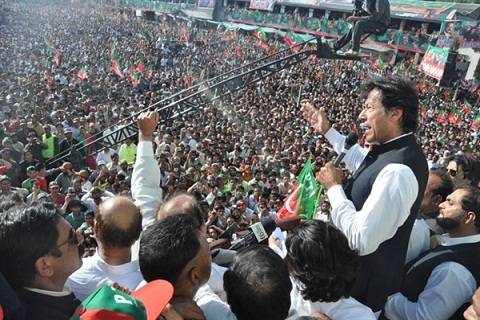A political party is defined as an organized group of people with ideology, aims and opinions that seek to influence public policy by getting its candidates elected to public offices. Lawrence Lowell (1913) argues that essential function and the true reason of a political party’s existence is bringing public opinion to a focus and framing issues to a popular verdict. So, the ultimate goal of any political party is to acquire political power through contestation of elections.
On April 24, 2016, Pakistan Tehrik-e-Insaf (PTI) celebrated her 20th birthday in F-9 Park, Islamabad. This long walk began in the turmoil period of ‘democratic era’ of 90s when two of the major political parties PPP and PML-N enjoyed political power. Both the political parties were unable to complete their five year terms in office because of the excessive use of article 58-2B by the then presidents. The main allegations were of corruption, bad governance and bad economic conditions of the country.
In this scenario, Imran Khan, a legendary cricketer and a social worker, launched his movement against injustice and corruption named Pakistan Tehrik-e-Insaf. He gave solemn pledge to wipe out corruption and injustice from Pakistan. In 1996, on the inauguration of his political party, Imran vowed to bring new leadership on the political stage under the banner of his political party. He believed that the current corrupt political set up is full of feudal lords, mill owners and tribal chiefs who have no connection with the masses of Pakistan, thus it is inevitable to bring new, clean and visionary leadership to lift the country from instability, fragility and weakness to a prosperous country. But the questions arise here: Over the last two years to what extent has Imran succeeded in his above mentioned agenda? Are feudal lords, industrialists, tribal chiefs/sardars necessary to win majority?
After her admission into political arena, PTI’s first assignment was the election of 1997 in which no contestant of PTI won in National or Provincial assemblies of Pakistan. Almost similar results were seen in next general elections of 2002, when PTI manage to win only one seat from Mianwali when Chairman Imran Khan defeated a local transporter with a margin of mere ten thousands votes. PTI chooses to boycott the upcoming general election in 2008, arguing that these elections will not be free, fair and transparent under the incumbent president General (R) Pervaiz Musharraf.
PTI’s stance of bringing educated, clean and honest leadership doesn’t work for the cause. After the participation in mass movement of restoration of judiciary, PTI changed her policy. Now, PTI’s doors were open to the traditional politicians who were unable to win the recent elections. With the exit of General Musharraf and the low performance of PML(Q) in polls, many district level politicians began to join emerging PTI.
In October 2011, there came a peak point of PTI, when Lahore witnessed probably one of the biggest gatherings after the historic Pakistan’s Resolution Session in 1940 at Minar-e-Pakistan ground. This massive gathering attracted numerous main stream politicians to join Imran khan. Few months later, PTI staged another massive show of power in Karachi. With this PTI began to admit any notable figure forgetting her ideology of bringing clean, honest and new leadership.
In 2013 general election, PTI performed well. With the second highest votes it became the 2nd largest party in the country. It formulated coalition government in Khyber Pakhtunkhwa. PTI’s ideology to bring new faces into political arena met with failure which forced PTI to move towards electable candidates. Now PTI is full of bourgeois class including landlords, industrialists and financers. There is a core relation between finance and electoral performance. Billionaires of the party provide large amount of capital to strengthen their chance of survival in national political arena. Traditional political figures are awarded tickets in elections, so that they can use their rural political support combined with leadership’s charisma into electoral success.
After 20 years, PTI has lost her track. Still it vows for change. Still it appeals to nation to strengthen the “new” leadership’s hands to eliminate corruption, bad governance and injustice from the country. Still, PTI wants to build “New Pakistan” with old architects. Still, PTI portrays herself as an “ideological” political party. Still PTI represents herself and its leader Imran Khan as “the last hope” of the nation.






